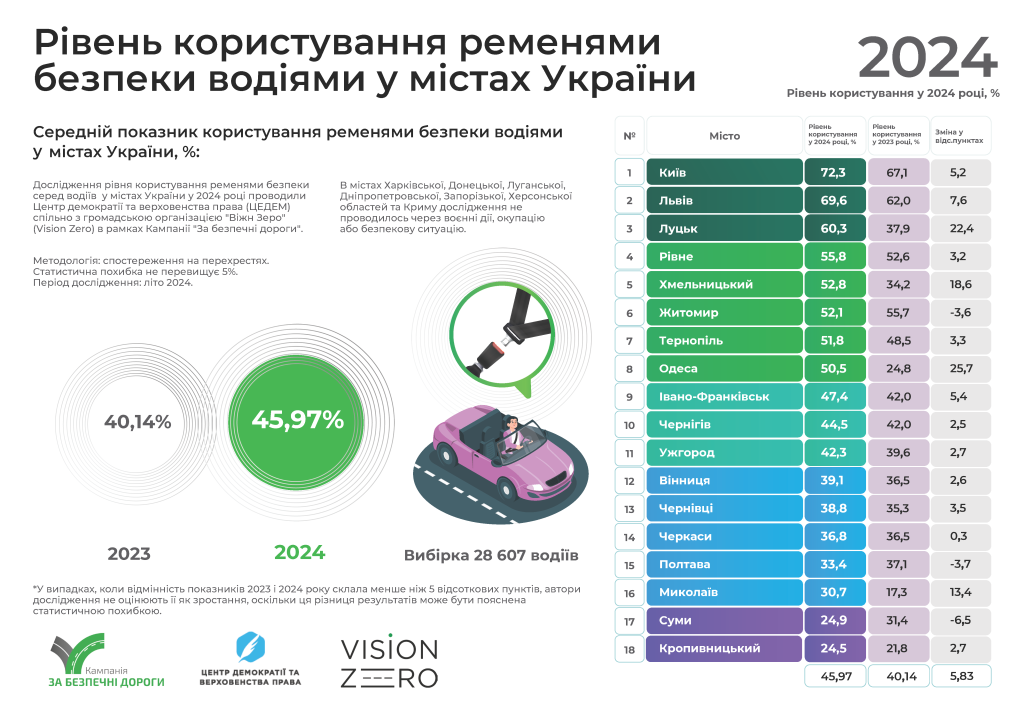
More than half of drivers in Ukraine still do not use seat belts, and only 46% buckle up behind the wheel . Such data was shown by this year's study entitled "The level of seat belt use among drivers in Ukrainian cities." It was conducted by public organizations Center for Democracy and Rule of Law (CEDEM) and " Vision Zero" as part of the "For Safe Roads" Campaign.
The research was carried out by observing drivers in different cities of Ukraine. A total of 28,607 drivers in 18 regional centers were covered. The campaign "For safe roads" has been conducting such studies since 2017 in order to draw attention to the problem of neglecting seat belts and change society's attitude to this phenomenon. According to WHO estimates, up to 50% of fatalities in fatal accidents could be saved with the use of a seat belt.

"Back in 2017, we chose three key risk factors identified by the WHO. The first was excessive speed, and then we particularly sought to increase the level of use of seat belts and child seats. After all, there is a direct connection between wearing seat belts and the severity of the consequences of an accident. Over the years, we have all done tremendous work in the field of increasing the level of seat belt use," Olesya Kholopik, director of TsEDEM, emphasized.
On average, the level of use of seat belts in the studied cities reached 45.97%. However, compared to last year, there is a positive trend — the number of drivers who buckle up has increased by 5.84%. For comparison, in 2017, only 15% of drivers used seat belts!

"This is a significant increase even compared to the previous year, and compared to the "pre-war" times, the level of use has doubled," emphasized Viktor Zagreba , a researcher of public policy on road traffic safety of the "For Safe Roads" Campaign.
The positive dynamics are even more noticeable in a number of cities that are among the leaders: Kyiv (72.3%), Lviv (69.6%) and Lutsk (60.3%). Here, the use of seat belts has become a social norm, and those who do not fasten themselves are in the minority. At the same time, in Mykolaiv, Sumy and Kropyvnytskyi, such drivers are less than a third of the total.
The study showed that in 15 out of 18 studied cities there was an increase in the share of drivers using seat belts in accordance with the requirements of the Road Traffic Rules. The highest growth in the level of use was recorded in Odesa (+25.7%) and Lutsk (+22.4%). At the same time, in 3 cities - Zhytomyr, Poltava and Sumy, the level of seat belt use has slightly decreased compared to 2023.
According to Viktor Zagreba, in general the result is extremely positive, because in 2018-2020 there was not a single city where more than half of the drivers used seat belts. "Those who follow the rules have always been in the minority. Now we have 8 cities where more than half of drivers buckle up, twice as many as last year. I would also like to note that in no city was there a level of fastening lower than 20%. And 4-5 years ago, in some cities, almost no one buckled up at all," he emphasized.
Olesya Holopik notes that among the reasons for such positive changes are changes in legislation in recent years. In particular, the fine for ignoring seat belts was increased from 51 to 510 hryvnias, and the exceptions that allowed drivers, taxi passengers, and instructors not to wear seat belts were canceled.

As Maksym Shulga, an analyst of the "For Safe Roads" Campaign , emphasizes, in general, people's views on this issue are changing.
"Previously, seat belts were something that had to be put on in order not to be stopped by the traffic police. Now, thanks to the media, people see that accidents happen all the time, with many dead and injured. So it becomes clear: a simple habit that takes 2-3 seconds can save a life. I think that because of the war, people realize that life must be valued, because many give it for the country, so efforts must be made to save life here," he explained.
The "For Safe Roads" Campaign notes that, despite the change, the topic of seat belts remains relevant, because now we are at the stage of practical implementation of changes and monitoring of compliance with the rules.
Organizers and authors
The study "The level of use of seat belts among drivers in the cities of Ukraine" in 2024 was conducted jointly by the public organizations "Vision Zero" (GO "Vizhn Zero") and the Center for Democracy and the Rule of Law (CEDEM) as part of the "For Safe Roads" Campaign .
Research leader: Viktor Zagreba, research coordinator: Maksym Shulga. The organizers express deep gratitude to the representatives of civil society who acted as observers and collected information on the streets of cities.
The campaign "For safe roads" is an advocacy campaign aimed at reducing the number of deaths and injuries on the roads of Ukraine. Initiated by the Center for Democracy and the Rule of Law in partnership with the NGO "Vision Zero", U-Cycle brings together international and Ukrainian experts, representatives of the legislative and executive authorities.
About the research:
The study was conducted by the observation method, in accordance with the guidelines of the World Health Organization "Seat-belts and child restraints: a road safety manual for decision-makers and practitioners" (2009).
The average sample of drivers in each studied city was 1589 people, and in total - 28607 people. In each city, measurements were carried out in 4-6 places located in different parts of the city. The static error of measurements in cities is no more than 5% with a confidence interval of 95%. According to the methodology, drivers of cars, trucks, and minibuses are included in the study, but drivers of regular city, suburban and intercity public transport, special and emergency service vehicles, and military vehicles are not included.
Observers used a visual method of obtaining information, choosing the most convenient places for observation to minimize the possibility of errors or the inability to detect the presence or absence of a seat belt on the driver's shoulder. Observers filled out special counting forms and took photos at the place of observation. At the same time, the surveillance was carried out in such a way that the drivers did not know that they were being monitored. The results of observations from each city were verified by the organizers, and their selective verification was carried out by the method of control measurements.
The average national indicator was calculated as the arithmetic average number of indicators in the studied cities. The results of the study do not take into account the differences in the population in the studied cities, the level of use of seat belts in other cities, small settlements and on roads outside the boundaries of settlements.
Important: In 2024, the organizers did not conduct research in Kharkiv, Siversko-Donetsk, Mariupol, Dnipro, Zaporizhzhia and Kherson, as well as the Autonomous Republic of Crimea. Reason: hostilities / temporary occupation, proximity of hostilities, etc. The lack of observations in these cities encourages us to interpret the average indicator found with caution, because in the case of obtaining data from these cities, this indicator may change.
